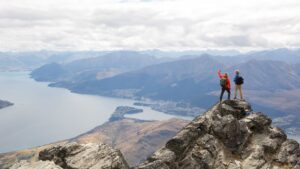Tim Treadgold: The return of Misima and why Kingston is a red-hot spec

Pic: Tyler Stableford / Stone via Getty Images
There was in 1999 a very good reason for deciding to close the Misima goldmine in Papua New Guinea. Somewhat oddly, it’s exactly the same reason to start again today.
The price of gold, which had plunged to $US252/oz ($374/oz) in May 1999, at the start of a gold-selling program by the Bank of England, determined the fate of the mine 21 years ago, whereas the current price of $US1553/oz underpins plans to redevelop Misima.
There are other factors in play, good and bad, but on balance the positives outweigh the negatives and make Kingston Resources (ASX:KSN), the company behind the return to Misima, one of the Australian stock market’s better gold exploration and development stories.
Located on Misima Island, which is one of the easternmost parts of Papua New Guinea, the mine has a history dating back more than 130 years with first production reported in 1888.
The young geology of the region, which is dominated by volcanic activity associated with the Ring of Fire that circles the Pacific Ocean, has revealed some of the world’s great gold and copper deposits on islands such as Lihir, Simberi, Woodlark, Bougainville, and Misima.
The relatively soft rock which holds most of Misima’s gold is a factor in turning ore grading little more than 1 gram per tonne (g/t) into a profitable operation thanks to the low energy requirement in crushing and processing.
After its early years as a prospector’s paradise, it was a Canadian company, Placer Dome, which put Misima on the global gold map, successfully operating on the island for 15 years between 1989 and 2004 at an average annual production rate of 230,000oz at a cost of just $US218/oz.
What stopped Placer Dome was the Bank of England’s 1999 decision to sell the lion’s share of its gold reserves in what ranks as one of the world’s worst-ever business decisions, launching a process which saw 395 tonnes of gold traded in 17 auctions that ran until early 2002.
Virtually from the day the bank said it was a seller Misima was doomed because Placer Dome needed to invest in a major pit expansion (cutting back the walls) to maintain production, an investment which didn’t make sense with the easier options being to run the mine down; which is what happened and why final closure was delayed until 2004.
For the past 17 years there has been no mining on Misima, which is located about 625km east of PNG’s capital, Port Moresby.
But the ground has been picked over by a number of interested companies, including a pair of Japanese copper miners who suspected that under the near-surface gold lies a big copper deposit, similar to Panguna on Bougainville island to the north of Misima.
Kingston entered the race to re-start goldmining on Misima three years ago when it joined a partnership with Japan’s Nippon Metals and Mitsui Mining, but is now in the final stages of lifting its stake in the project to 100 per cent.
Waking the beast
What Kingston has at Misima is, at this stage, largely what Placer Dome left in 2004, an impressive 2.8 million ounces of gold in a large but low-grade resource measuring 82.3 million tonnes of material at 1.1g/t.
It’s from that starting point that Kingston is exploring with a two-rig drilling campaign testing a number of locations for richer pods of ore to boost early-stage production.
The drilling, so far, has revealed three main targets for early ore. Umuna East which is located about 500m from the abandoned main Umuna pit last worked by Placer Dome, Misima North and Quartz Mountain to the west of Umuna.
News flow from Misima is accelerating as assays tumble in.
Mid-December saw encouraging channel samples close to the surface taken from the Abi prospect in the Quartz Mountain area including 7.7m at 20.87g/t.
Mid-January saw drilling return assays of up to 4.55g/t over 8.4m from a depth of 23.8m, and late last month drilling at Umuna East returned assays of 1.31g/t over 12m from a depth of 2m and 2.32g/t over 6m from 80m.
Kingston chief executive Andrew Corbett said each location of drilling was an important step towards delineating mineralisation to underpin potential starter pits.
Canaccord Genuity, a Canadian stockbroking firm familiar with the history of Misima when it was run by Placer Dome, is a leader of the Kingston cheer squad, forecasting the potential for Misima returning as a project producing up to 180,000/oz of gold a year at an all in cost of $1230/oz (US$824/oz) over an 11-year campaign.
The capital cost of a revitalised gold operation on Misima is likely to be in the order of $200m with everything new because Placer Dome fully rehabilitated the site, while leaving good roads, port and a skilled workforce keen to see a resumption of mining.
Unlike Bougainville, and other parts of PNG, Misima has never suffered from social unrest with the island a recruiting ground for other projects with some Misima locals working on a fly-in, fly-out basis at mines elsewhere in PNG.
On the market, Kingston has been slow to attract a following, partly because it is at a relatively early stage of exploration (even though it has a big resource in hand), and also because of PNG’s bad reputation with investors.
Over the past 12-months the stock has been stuck at 19c, a country mile below Canaccord’s price target of 60c and even further behind the 80c price tip from Avoca Capital.
READ MORE from Tim Treadgold:
Jupiter is rising (at last)
Orion poised to reveal all, or relive another Groundhog Day
Back to work at Mandilla after the hatchet is buried at Anglo Australian
Related Topics

UNLOCK INSIGHTS
Discover the untold stories of emerging ASX stocks.
Daily news and expert analysis, it's free to subscribe.
By proceeding, you confirm you understand that we handle personal information in accordance with our Privacy Policy.








